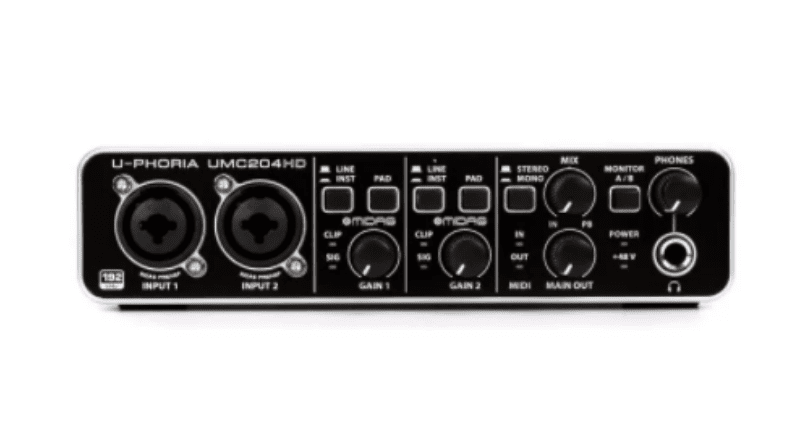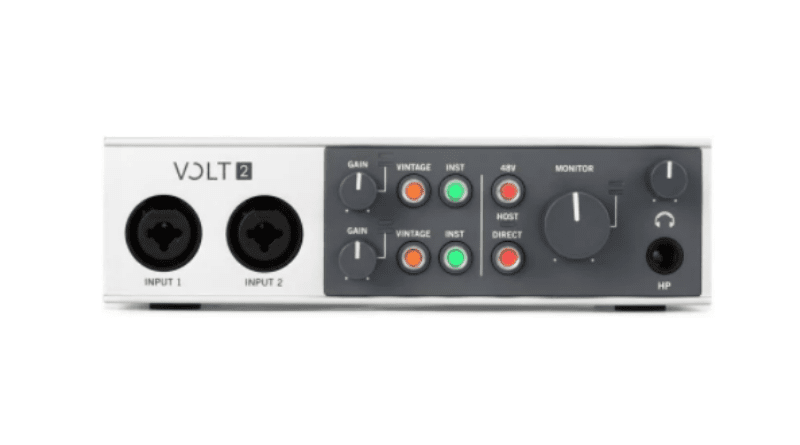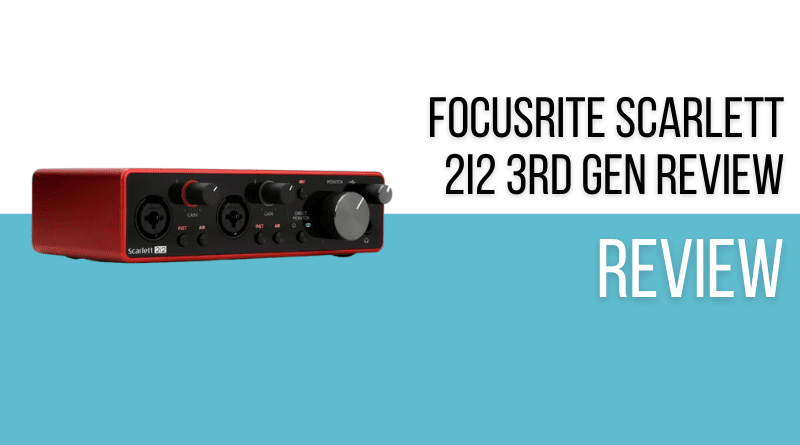The Focusrite Scarlett 2i2 3rd Gen is the latest version of Focusrite’s incredibly popular USB recording interface. It was released in 2019 alongside the rest of the 3rd Gen range, and featured improvements in practically every category over the outgoing model.
We’ve actually used the old version in the past, and we were excited to see how the new model stacked up. Read on to find out how it performed.
Read more about our review process.
Contents
Who Is the Focusrite Scarlett 2i2 For?
The Focusrite Scarlett 2i2 is perfect for a wide range of users. It works well for guitarists and singer songwriters to record entire tracks using their home computers, and similarly, it works well for podcasters trying to make high quality recordings.
The simple setup and tiny footprint make it an ideal unit for those new to home recording, but the fantastic audio quality is sufficient to keep even seasoned pros happy with this as part of a home studio rig.
Appearance / Features / Controls
Externally, there’s not a lot to the 2i2. It comes finished in the classic Focusrite red aluminum housing, a touch that we really like. It looks great on the desktop, and that’s key in a home setup.
The control panel somehow manages to look less cluttered than the outgoing model, while gaining extra buttons. This is probably because the buttons on the 3rd Gen have been finished in a lovely matte black color, which does a good job of camouflaging them.
The 2i2 has 2 input channels, both which can be used for either instrument or microphone (XLR) in (if you only need one output, check out the Scarlett Solo). Next to each input there are 2 buttons labeled “Inst” and “Air”. By activating the “Inst” button, you’re letting the unit know that it’s receiving a guitar or bass signal generated by magnetic pickups, it will respond by optimizing the input gain and impedance to prevent input signal distortion. This feature was added in response to the extreme clipping that older generations famously suffered from.
The “Air” button is designed to be used for vocals when a mic is plugged in by XLR. The function of this control is to increase the mid-high frequencies in the vocals that are often missing from inexpensive and budget microphones. It works wonders for adding detail and clarity to vocal tracks, and is a welcome feature on this new edition.
There are individual gain controls for both channels, and simple controls to switch between direct monitoring and having sound come through the computer. If you have someone recording while you mix, you can simultaneously output to headphones, and make use of the individual headphone monitor volume control.
This unit also has 48v phantom power, activated by a switch on the front of the unit, so there’s no need for separate power for your condenser mics.
Performance/Sound
We loved how easy it was to get started with the 2i2. After getting plugged in to the computer (we were using a MacBook Pro), it immediately prompted us to visit the Focusrite website to download the appropriate drivers and software to run it. In all, it took us about 20 minutes to be in a position to start using the interface – your time may vary depending on the speed of your internet connection.
We started with some guitar tracks, recording with the “Inst” function activated. With a dry signal, we were able to have the gain set way up and we were still left with tons of headroom. This gave us a lot of scope to play with amplifier and FX plugins.
While we got some fantastic results with a dry signal in to the interface, when we played through a high gain distortion pedal (Donner Dark Horizon), we found that the unit was clipping quite early, which really killed the tone. With the input gain set to a little over 9 o clock we were able to get a decent recording, but it didn’t sound quite as good as the dry signal with plugin distortion FX.
In order to monitor the clipping, the 2i2 has the Focusrite Halo system. This is essentially a convenient light that surrounds the gain knob, and lights up green when the signal is being fully captured, orange when it’s hitting the threshold, and red when it’s being clipped. It did make it easy to spot any clipping issues in real time while recording, and that was a huge time saver.
We tested the mic input for spoken vocals using a Shure SM7B. This is a notoriously dark sounding mic, but we found that with the “Air” button activated, it was noticeably brighter, without losing the beautifully balanced tone that this mic is so famous for. It mellowed out the bottom end, and ultimately left us with a great recording.
Next, we turned off the air function and close mic’d an SM81 (our favorite mic for recording acoustic guitars) to a Martin 000-15M. We were really happy with the retention of the warmth that this all mahogany acoustic guitar gives us in person. As with the dry signal on the ¾” Jack in recording, we had a ton of headroom, and a wonderfully clear recording.
Other Interfaces to Consider
If you aren’t sold on the Focusrite Scarlett 2i2 3rd Gen, there are still a number of other great 2 channel interfaces to choose from – take a look at these excellent alternative options:
Behringer U-Phoria UMC204HD

The Behringer U-Phoria UMC204HD is one of the best value USB interfaces on the Market. Like the 2i2, it has 2 input channels, both of which are able to accept XLR or ¾” jacks, giving you the option to record mics, guitars, and keyboards with ease. It offers extremely low latency, and studio quality resolution.
Universal Audio Volt 2

The Universal Audio Volt 2 is a unique USB interface that appeals to fans of vintage tones in particular. It’s made with analog circuitry, which gives vintage style recordings the type of organic warmth that’s missing from many digital interfaces. As with the other options, it does feature 24 bit/192kHz AD/DA conversion, resulting in high fidelity captures and great sound quality.
Final Thoughts on the Focusrite Scarlett 2i2 3rd Gen
There’s a good reason that the Focusrite Scarlett 2i2 3rd Gen has become an industry standard USB interface. The preamps are so well designed that the audio quality is way beyond anything that has previously been possible in a unit this size.
It’s incredibly simple to use, and because its USB powered, it doesn’t introduce additional electrical noise into your recordings, and takes up very little desk space. Considering how feature packed it is, it’s a steal at the price, and we can’t recommend it highly enough.


